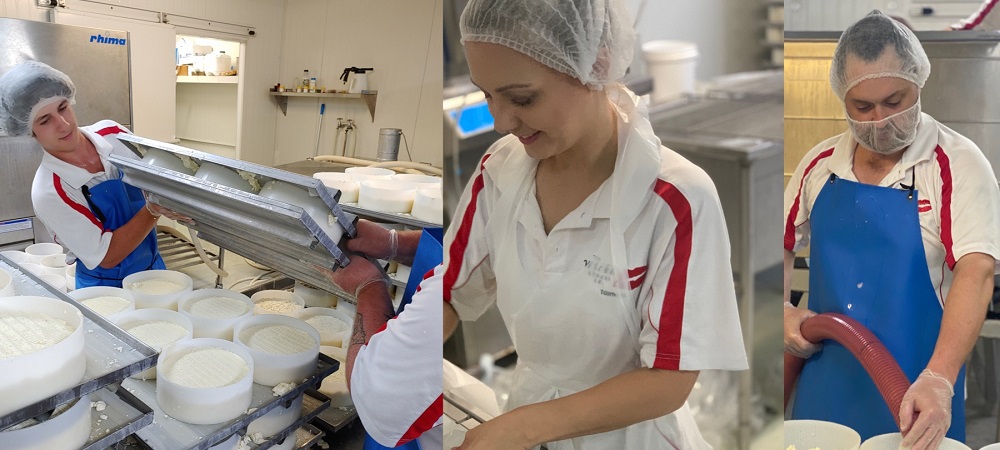Premier Cheese Makers in Melbourne: The Story of Floridia Cheese Thomastown
Premier Cheese Makers in Melbourne: The Story of Floridia Cheese Thomastown
Blog Article
Unlocking the Secrets of Artisanal Cheese Making: A Detailed Do It Yourself Guide
In the realm of cooking craftsmanship, artisanal cheese making stands as a testimony to the delicate equilibrium between custom and innovation. Each action in the process, from choosing the appropriate milk to developing aging techniques, holds within it a riches of knowledge gave with generations. As we start this trip to demystify the art of creating splendid cheeses, we are encountered with a tapestry of skills and secrets waiting to be unraveled. Join us as we discover the details of this old craft, where science, art, and patience assemble to produce flavors that entice the senses.
Choosing the Right Milk
When embarking on the trip of artisanal cheese production, the selection of milk plays an important duty in identifying the top quality and characteristics of the last item. The type of milk picked affects the taste, appearance, and overall profile of the cheese.
When selecting milk for cheese making, it is necessary to take into consideration the fat content. Greater fat material in milk can lead to a creamier and richer cheese, while reduced fat content may lead to a drier and stronger structure. Additionally, the source of the milk, whether from cows, goats, lamb, or buffalo, adds distinctive tastes and attributes to the cheese (Floridia Cheese). Each kind of milk brings its own subtleties, allowing for a vast array of cheese ranges to be crafted based on the selected milk. Eventually, the option of milk is a fundamental choice that sets the structure for an effective artisanal cheese-making undertaking.
Culturing and Coagulating
To start the cheese-making process, the critical actions of culturing and coagulating must be very carefully performed to change milk right into curds and whey. Culturing entails introducing useful germs to the milk, which then begins the fermentation procedure. These microorganisms convert lactose (milk sugar) right into lactic acid, creating the acidic atmosphere essential for coagulation. The kind of culture used can substantially influence the flavor, texture, and ripening of the last cheese product.
.jpg)
The timing and temperature control throughout culturing and coagulation are critical aspects that influence the last outcome of celebrity. Proper implementation of these actions is vital to make certain the wanted structure, flavor, and uniformity of the artisanal cheese being generated.
Draining and Pressing Curds
After the milk healthy proteins have actually coagulated and the curds have been cut to launch whey, the next important action in artisanal cheese making includes draining and pushing the curds to achieve the wanted texture and uniformity of the final cheese product. Draining is the process of separating the curds from the whey. This can be done by transferring the curds into a cheesecloth-lined bowl-shaped sieve or mold and enabling the whey to drain pipes off naturally. The time for draining can vary relying on the type of cheese being made and the desired moisture content.
As soon as the curds have adequately drained, the following action is pressing. Pressing assists remove any continuing to be whey and compacts the curds to create a solid cheese wheel. Pushing can be done making use of specialized cheese presses that use regular and mild stress over an amount of time. The duration and pressure applied throughout pressing will certainly affect the last structure of the cheese, from soft and luscious to hard and company. Proper draining and pushing are vital actions that considerably affect the quality and Get More Info characteristics of the artisanal cheese being produced.
Aging and Flavoring Strategies
Applying meticulous aging and flavoring techniques is critical in enhancing the depth and complexity of artisanal cheeses, boosting their preference profiles to splendid levels of refinement and elegance. Aging plays an essential function in establishing the special tastes and appearances that distinguish artisanal cheeses.
Seasoning methods likewise add significantly to the final taste of artisanal cheeses. Cheesemakers may select to present added flavors by including active ingredients such as natural herbs, seasonings, and even fruits into celebrity throughout the manufacturing procedure. In addition, some cheeses are cleaned or scrubed with different fluids, such as brine or alcohol, to improve their flavors and structures.
Wrapping and Saving Cheeses

Final Thought
In final thought, understanding the art of artisanal cheese making entails carefully choosing the best milk, adhering to accurate culturing and coagulating processes, draining pipes and pushing curds effectively, and using various aging and flavoring strategies. Remember to cover and store your cheeses properly to ensure optimal taste and structure growth.
Each kind of milk brings its own subtleties, permitting for a large variety of cheese selections to be crafted based on the picked milk.After the milk healthy proteins have actually coagulated and the curds have been cut to release whey, the next crucial step in artisanal cheese making includes draining and pushing the curds to accomplish the wanted appearance and consistency of the last cheese item. The majority of cheeses should be have a peek at these guys covered in wax paper or cheese paper to permit them to breathe while protecting them from drying out. For cheeses that require to proceed aging, such as bloomy rinds or cleaned peels, ensure they are saved in an awesome setting like a cheese cavern or a refrigerator established to the appropriate temperature level. By paying attention to the wrapping and storage space of artisanal cheeses, cheese manufacturers and lovers can preserve the stability of these delicacies and completely appreciate their complex tastes.
Report this page